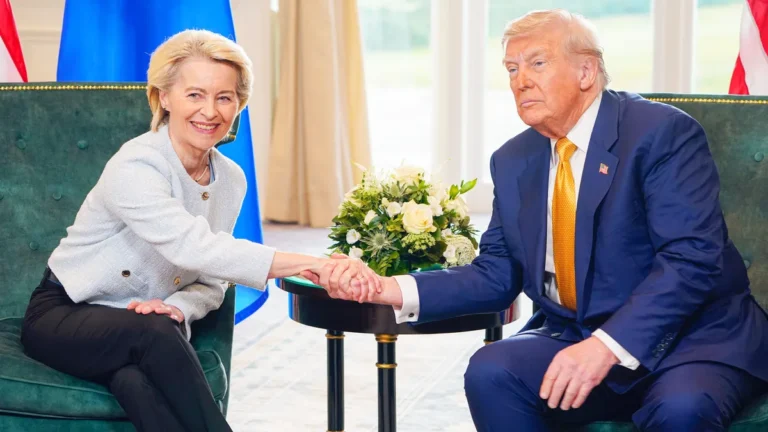Crypto News: Market Update July 2025
The U.S. economy came under increasing pressure in July 2025 from a range of factors: a cooling labor market, rising inflation, new import tariffs, and political tensions surrounding the Federal Reserve’s interest rate policy. While President Trump is pushing for substantial rate cuts, the Fed remains divided and cautious, partly due to persistent price pressures and international uncertainties. At the same time, financial markets – including the crypto sector – are showing strong risk appetite, signaling a disconnect between macroeconomic fundamentals and market sentiment. This report analyzes the key economic developments of July and the dilemmas facing policymakers.
July 3: Strong Job Growth Masks Loss of Labor Market Dynamism
In June 2025, U.S. employment grew by 147,000 jobs, mainly driven by the public sector. The private sector added only 74,000 jobs, marking the weakest growth in eight months. Unemployment fell to 4.1%, partly because people left the labor force.
At the same time, working hours and wage growth declined, and the number of long-term unemployed increased. Sectors such as manufacturing and professional services contracted, while growth was mainly concentrated in healthcare and social assistance.
Economists warn that the labor market is slowing down, which could potentially lead to interest rate cuts later this year. Employment dynamics are also being negatively affected by immigration policy and reduced labor supply. (Source: Reuters)
July 9: Fed Minutes Reveal Division Over Rates and Interest Outlook
The minutes from the Federal Reserve’s June 17–18 meeting are expected to provide deeper insight into the internal divisions over interest rate cuts and the impact of Trump’s new import tariffs. While some policymakers are considering a rate cut in July, most are waiting to see how the tariffs affect inflation.
Despite public pressure from Trump to aggressively cut interest rates, many Fed officials remain cautious. Uncertainty surrounding trade policy and its impact on the economy means that future rate cuts will depend on upcoming inflation and unemployment data. Analysts expect a clearer policy direction to emerge only in September, depending on whether the rise in inflation proves to be temporary or persistent. (Source: Reuters)
July 10: Bitcoin Breaks New Record Above $113,000 Amid Risk Appetite and Short Liquidations
On Thursday, Bitcoin reached a new record of $113,863, driven by increasing risk appetite among investors and a wave of short liquidations totaling $318 million within 24 hours. The price ultimately rose by about 2% to $113,459.
After weeks of sideways trading, Bitcoin remains above $100,000, supported by continued inflows into Bitcoin ETFs and purchases by publicly traded companies. The rise began on Wednesday, alongside a rally in the Nasdaq, and is bolstered by positive institutional interest and progress in U.S. regulation of stablecoins. (Source: CNBC)
July 15: Inflation Rises in June Due to Import Tariffs, Fed Remains Cautious
In June 2025, inflation in the U.S. rose by 0.3%, or 3.5% year-over-year, mainly due to higher prices for imported goods such as furniture, electronics, and clothing. This increase confirms the Federal Reserve’s concerns that President Trump’s tariffs are starting to impact consumer prices.
Hoewel Trump oproept tot renteverlagingen, blijft de Fed afwachtend. De kerninflatie steeg iets minder dan verwacht (2,9% op jaarbasis), maar de prijsdruk breidt zich uit. Economen zien in de cijfers duidelijke tekenen dat tarieven het prijsniveau verhogen, wat de kans op renteverlaging in juli klein maakt.
The Fed will likely intervene only in September, depending on how persistent the inflation increase proves to be. Uncertainty over further tariff hikes and their impact on growth and employment means policymakers will remain cautious for the time being. (Source: Reuters)
July 30: Fed Keeps Interest Rates Unchanged Despite Pressure from Trump and Internal Divisions
On July 30, 2025, the Federal Reserve kept its policy rate steady at 4.25% – 4.5%, despite strong pressure from President Trump to implement aggressive rate cuts. The vote within the FOMC was divided: two Fed governors voted against, marking the first time this has happened since 1993
Fed Chair Jerome Powell emphasized that no decision has yet been made regarding a rate cut in September. Inflation appears to be easing, and the economy grew by 3% in Q2, but uncertainty about the impact of new import tariffs makes the Fed cautious.
Despite Trump’s demand for a 3 percentage point rate cut, the Fed continues to maintain its independent course. Market expectations for a rate cut in September dropped from 64% to 46% following Powell’s statement. The next major update is expected at the Jackson Hole symposium at the end of August. (Source: CNBC)
July 31: U.S. Inflation Accelerates in June Due to Tariffs on Goods
In June, U.S. inflation rose again: the PCE price index increased by 0.3%, and core inflation reached 2.8% year-over-year. Prices for goods, such as furniture and recreational products, rose notably due to new import tariffs. This strengthens the expectation that the Federal Reserve will consider rate cuts only after October.
Consumer spending rose by 0.3%, supported by a stable labor market, but signs of weakening job growth and rising prices are putting future spending under pressure. The savings rate remained steady at 4.5%, while real disposable income stagnated. Inflation appears to be drifting away from the Fed’s 2% target, complicating policy decisions. Tariffs are causing price pressures, especially for low- and middle-income households, and companies like Procter & Gamble are raising their prices. Although the economy still grew by 3% in Q2, economists warn of slowed growth in the third quarter. (Source: Reuters)
Conclusion
The economic situation in the U.S. remains complex: despite solid economic growth in the second quarter and strong performance in sectors like cryptocurrency, the labor market shows signs of slowing down and inflation is starting to rise again. The Federal Reserve is balancing the risk of overheating caused by import tariffs against political pressure to cut interest rates. With divisions within the Fed, unpredictable trade measures, and uncertain inflation outlooks, policy decisions in the coming months will continue to depend on new data. The Jackson Hole meeting at the end of August and the rate decision in September will be pivotal for the direction of monetary policy in the final quarter of 2025.



